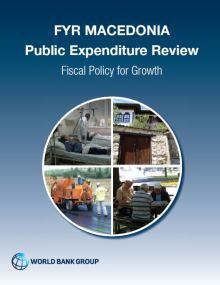Faced with a double dip-recession since the 2008 crisis, the Government engaged in expansionary fiscal policy, which helped sustain growth and employment, but resulted in increased public debt from low to moderate levels. FYR Macedonia’s public debt stood at 45.7 percent of GDP in 2002, as the country emerged from the 2001 conflict. Solid growth, a sound fiscal policy stance and pre-payments to the Paris Club enabled the country to reduce its public debt to 23.0 percent of GDP by 2008 – the lowest level during the decade. Since then, public debt has increased gradually to 46 percent in 2014, still below the SEE6 average of 52.6 percent in 2014.
| Full Report (PDF) |
|---|
The fiscal expansion of recent years has brought several weaknesses to the fore. We highlight three main ones:
- Weaknesses in Public Financial Management (PFM) have become more evident. Fiscal deficits have widened since 2011 and the Government has missed the fiscal targets set in the budget between 2012 and 2014. Budget execution, in particular of capital spending, remained weak, prompting the Government to move a large part of transport spending off budget in 2013. Budget transparency has weakened, as a result.
- Efficiency of public spending remains low. Compared with other countries in the region, the Government could achieve the same sector outcomes with lower spending, in particular, in education, infrastructure, and in social protection. This report also identifies significant efficiency losses in agricultural subsidies and health.
- Public debt is projected to increase moderately under the baseline scenario considered in this report, but is expected to rise rapidly if the current Government Program 2014-2018 were to be fully implemented. The Government Program seeks to improve the welfare of all citizens in FYR Macedonia by strengthening economic growth and competitiveness, including through large scale infrastructure investment. While this is commendable, an appropriate prioritization among the program components will be important in order to avoid a rapid increase in debt at a pace that would challenge sustainability.
The report suggests that the FYR Macedonian authorities make sustained efforts to strengthen public financial management, improve the efficiency of public spending and moderate ambitious plans to scale up infrastructure investments, with a greater focus on the quality of investment spending. With a relatively low level of revenues and sticky expenditure composition – 90 percent of total expenditures are for current outlays and more than 25 percent of current spending is pension-related - support to growth is unlikely to come from further tax cuts or large spending increases, as these would further increase government debt. Maintaining a manageable debt level is particularly important in the current uncertain external policy environment.
The report identifies short- and medium-term policy options in some key areas. Policy options focus on strengthening Public Financial Management, managing expenditures, and health and transport sector reforms. In addition, reforms of fiscal revenues and pensions remain critical for the future fiscal sustainability.
